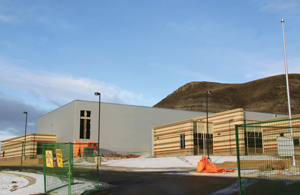
Residents living across the street from the new Elim Pentecostal Church, formerly Central School, may have noticed some strange things afoot at the building during the months of December and January.
Large gatherings outside the church at night, people running around with cameras, weird uniforms, guns, and shouting would have given anyone peering out their front window some confusion.
Fortunately, nothing unseemly was happening, the clandestine activities were the principal photography of a new movie being filmed in Drumheller.
Remember, a new movie by Airdrie based MovieMakers, was shot using the scenic badlands as a background for the science fiction tale of mystery and deception.
The story follows Captain Carl Onoway, played by Justin Lewis, an animation specialist who has won contests for his acting ability. Captain Onoway is charged with protecting children in a near future where parents are no longer allowed to keep their children. Instead, the state takes children away from their parents at birth to raise in state run facilities.
“It came from Plato’s Republic, not totally, but that’s where the idea comes from,” said Greg Lammiman, producer and co-founder of MovieMakers.
In Republic, a dialogue between philosophers explores the ideas of justice, utopia, and the role of the state. One of the ideas was that parents should be selectively bred and their children be raised by the wise philosopher kings.
Another aspect to the state run future in Remember is the use of memory blocking drugs. Whenever a person suffers a traumatic incident they are given drugs so they no longer remember what had happened. The drugs then became another tool used by the state to control its citizens.
“What if it got out of hand, that every time people had uncomfortable memories, they would just take the drugs and it became pervasive. You would have a weak society and the government could use that to control the masses,” said Greg.
The events begin when Captain Onoway suffers another traumatic incident and is forced to up his dosage of the memory blocking drug. When someone begins freeing children from the state run facilities, it is up to Onoway to investigate and stop them.
“It’s got a lot of elements in there and a lot of interesting twists,” said Greg.
Starring alongside Lewis is Rachel Peacock, whom some may know from the Rosebud Theatre, as Carl’s wife Wendy Onoway. Scott Heatcoat plays Onoway’s partner Lieutenant Andrew Turner. There are many other faces that some will recognize from Rosebud Theatre or Passion Play, and are providing support roles in the movie.
“We know a lot of Rosebud people, which gives us an acting pool, and we’ve been in the Passion Play for eight years as a family, so we have a lot of connections with actors that way,” said Greg.
The entire movie is being filmed in Drumheller, utilizing the town’s world famous scenery to add an otherwordly element to the film.
“It’s a great setting for a sci-fi, especially with the snow. I love how it looks with the snow,” Dallas Lammiman, the young filmmaker directing the project. Much of the outdoor shooting took place around the Passion Play site in December.
Indoor shooting was done primarily in the Elim Pentecostal Church. The church, because it is such an old building, was chosen for the many different looks, going from a dormitory, to prison, to police headquarters within a few metres.
“What a facility, there are so many different looks in the building it makes it look like so many different locations,” said Greg.
MovieMakers was created in 2006 by Dallas and his father Greg. Soon after, the whole family became involved. The business has focused mostly on educational films, such as The Amazing Map, Subitize Me, and Movie Making 101. Remember will be their first feature length fictional film.
“That has been the goal since day one. We started with the educational films and then some documentary films. September came around and we decided to take the plunge. We’re amazed how it’s all come together,” said Greg.
Filmmaking hasn’t been a lifelong dream for the young filmmaker, but a passion for the arts led Dallas inexorably down the path of movie making.
“Sixteen was when I decided this was what I wanted to go into. It had always been art, but I wasn’t sure what area. Film brings them all together, a combination of them all,” said Dallas.
The inspiration for Dallas to get into filmmaking was listening to filmmaker Robert Rodriguez, whose works include movies for younger crowds, such as Spy Kids, to movies that are not for the faint of heart, such as Planet Terror or Machete. Dallas credits the commentary by Rodriguez in Spy Kids 2: Island of Lost Dreams as giving him the motivation to start making movies.
“The commentary didn’t talk so much about the movie itself, it was more talking to young filmmakers and encouraging them,” said Greg.
When asked what advice he would give to young filmmakers, as Rodriguez had done, Dallas replied that young filmmakers get too hung up on equipment, rather than making a good story.
“Generally you just go out and do it. With the equipment, there are not a lot of barriers to entry anymore. It’s a minor thing though, if you’ve got a good story, equipment doesn’t matter,” said Dallas. “It’s more about the creativity of the individual holding the camera.”
Dallas does not have formal education in cinematography, but is passionate about learning through books, movies, and with the help of a community of indie filmmakers with as much enthusiasm as he.
Remember has resumed shooting after taking a break for the holidays. Filming should be complete by the end of January, followed by post production work, and release scheduled later this year.
“We’re hoping it won’t take more than six months to edit, but sometimes things get out of hand,” said Dallas.
For more information about the movie or to pre-order a copy, visit its website www.theremembermovie.com or the Remember Facebook page.



















